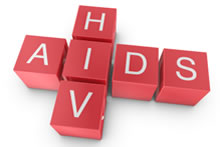
Despite efforts to reduce disparities in HIV transmission among gay men and other men who have sex with men (MSM) in the United States by optimizing treatment outcomes, significant racial disparities in HIV prevalence will likely persist for decades due to an alarmingly high concentration of HIV in black gay men, a new report finds.
Black MSM in the U.S. have been disproportionately affected by HIV since the beginning of the epidemic, although studies show that black men do not engage in more risk-associated behaviors than white men, and are just as, if not more, consistent about condom use and HIV testing. Yet disparities in HIV incidence and prevalence between black and white MSM in the U.S. remain largely unexplained.
Reporting in the November 18 online edition of The Lancet HIV, researchers from Emory University Rollins School of Public Health in Atlanta and amfAR, The Foundation for AIDS Research, assessed how existing disparities in HIV prevalence and in the HIV continuum of care explain differences in HIV incidence in MSM. The HIV care continuum has emerged as an important way to measure HIV/AIDS care and identify gaps along the continuum of HIV services, including testing, diagnosis, treatment, and ultimately, viral suppression.
"Our findings show the substantial challenges that remain ahead in our efforts to reduce and eliminate racial disparities in HIV incidence among black and white MSM here in the U.S.," says Eli Rosenberg, PhD, assistant professor of epidemiology at Rollins School of Public Health and lead author of the paper. "There is an urgent need to improve our rates of HIV testing, linkage and retention in care, and prescription of and adherence to antiretroviral therapy for black men living with HIV."
Using data from the Centers for Disease Control and Prevention (CDC) on people with HIV from 2009 to 2010, the researchers analyzed separate HIV care continuums for black and white MSM, and estimated how many were infected but undiagnosed; diagnosed but not receiving antiretroviral therapy; and virally suppressed. Additionally, multiple intervention scenarios were created to hypothesize the effect of care for black MSM if they achieved the same degree of HIV care as white MSM; had levels of 95 percent diagnosis; 95 percent retention in care; or both.
The analysis showed that health care outcomes were worse among black MSM with HIV than white MSM with HIV. White and black MSM have similar numbers of new HIV infections per year (9,710 among white MSM compared with 9,833 among black MSM), but the total black MSM population is smaller and the proportion of HIV prevalence is greater, resulting in greater disparities in HIV incidence between the two populations. In 2010, 32 percent of all black MSM in the U.S. were living with HIV, compared with only 8 percent of white MSM.
Disparities were also noted at all stages of the HIV care continuum – only 33 percent of HIV-positive black MSM were retained in care, compared with 51 percent of white MSM; and only 16 percent of black MSM were virally suppressed, compared with 34 percent of white MSM.
The modeling analysis found that optimizing HIV testing and retention in care will only have limited impact in reducing the disparities in rates of new HIV infections in the near-future. Because a larger proportion of black MSM are living with HIV, the researchers posit that if black MSM achieved the same degree of HIV care as white MSM, the racial gap in new infection rates would be reduced by 27 percent. If black MSM with HIV had 95 percent diagnosis, or 95 percent retention in care, or both, the reduction would be 27 percent, 25 percent, and 59 percent, respectively.
"We have an opportunity to change the course of the epidemic here in the U.S. by implementing the steps laid out in the National HIV/AIDS Strategy by focusing on the populations at greatest risk and ensuring that all men who have sex with men, especially black MSM, have access to healthcare," says Greg Millett, amfAR vice president and director of public policy, and one of the co-authors of the study. "We must also scale up programs for medications that prevent HIV infection at reduced or no cost for uninfected black gay men, while continuing to invest in research toward a cure and a vaccine. Otherwise, these disparities in HIV incidence among MSM will persist."
The study was funded by the National Institutes of Health.
About amfAR
amfAR, The Foundation for AIDS Research, is one of the world’s leading nonprofit organizations dedicated to the support of AIDS research, HIV prevention, treatment education, and the advocacy of sound AIDS-related public policy. Since 1985, amfAR has invested more than $388 million in its programs and has awarded grants to more than 3,300 research teams worldwide. For more information, please visit www.amfar.org.
About Emory University Woodruff Health Sciences Center
The Robert W. Woodruff Health Sciences Center of Emory University is an academic health science and service center focused on missions of teaching, research, health care and public service. Its components include schools of medicine, nursing, and public health; Yerkes National Primate Research Center; the Emory Winship Cancer Institute; and Emory Healthcare, the largest, most comprehensive health system in Georgia.
